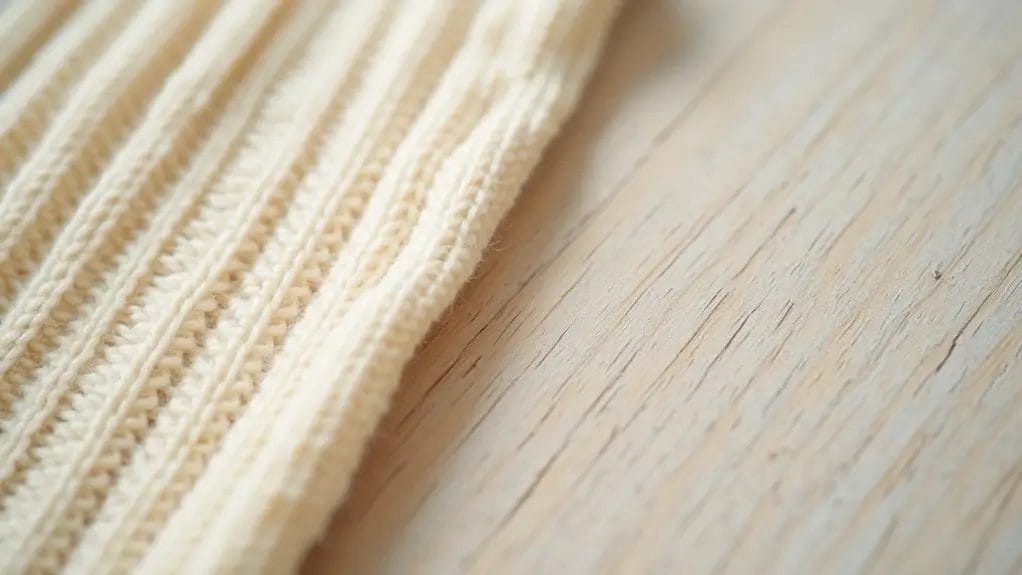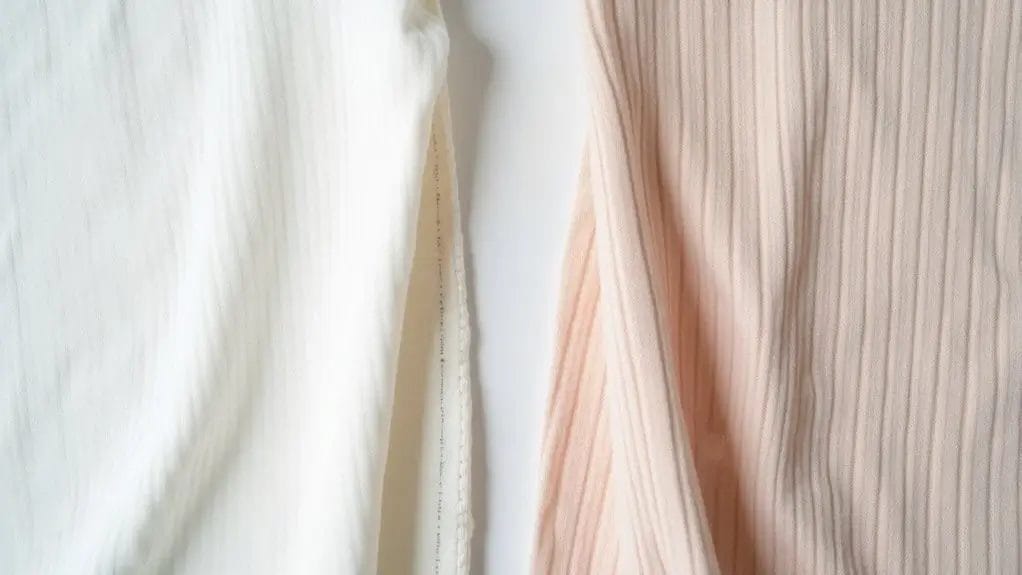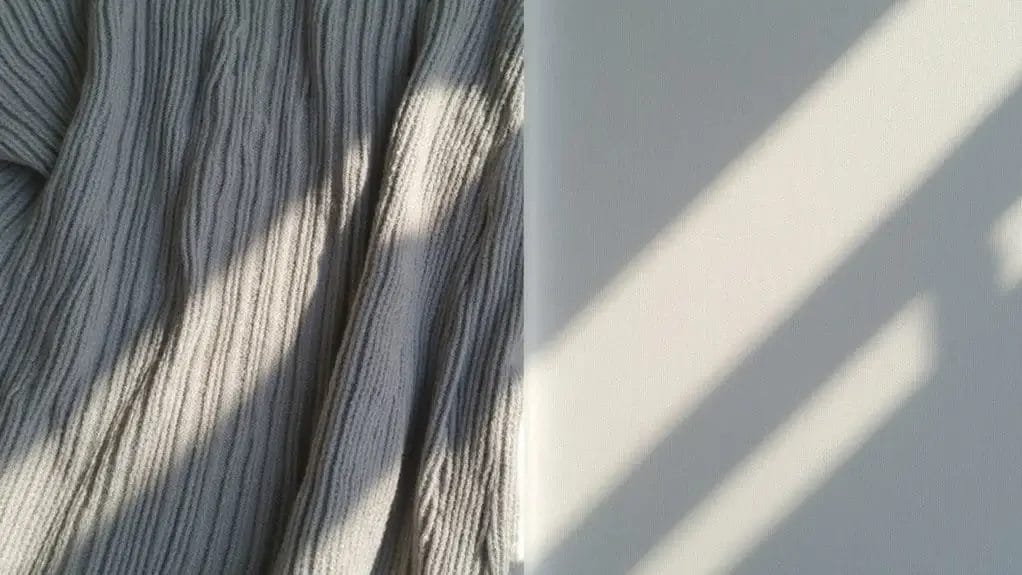You'll find that knit fabrics aren't created equal, and the differences between rib knit and jersey knit extend far beyond their surface appearance. While both materials stem from interlocking yarn loops, their distinct construction methods yield contrasting properties in stretch, stability, and end-use applications. Understanding these technical variations won't just help you choose the right fabric - it'll transform how you approach garment construction and textile selection.
Key Takeaways
- Rib knit has a distinctive ribbed texture with vertical lines, while jersey knit has a smooth face and slightly textured back.
- Rib knit offers superior bi-directional stretch, whereas jersey knit primarily stretches horizontally.
- Jersey knit is lighter and more breathable, while rib knit is heavier due to its double-layered structure.
- Rib knit excels in shape retention and durability, making it ideal for cuffs and waistbands.
- Jersey knit is easier to sew and drapes better, while rib knit requires specialized sewing techniques.
Overview of Rib Knit Fabric

Rib knit fabric features a distinctive vertical ribbed pattern created by alternating raised and lowered columns of stitches in a knit-one, purl-one sequence.
You'll find this textile structure creates natural elasticity and superior stretch recovery in both horizontal and vertical directions, particularly in comparison to other knit varieties.
The fabric's technical properties make it ideal for garment components requiring snug fits and retention of shape, such as cuffs, collars, waistbands, and form-fitting activewear.
Characteristics of Rib Knit
The distinctive structure of rib knit fabric features alternating raised and recessed vertical lines created through a specific knitting pattern of knit and purl stitches.
You'll notice the raised ridges form prominent vertical ribs on both sides of the fabric, creating a symmetrical texture. This unique construction allows for exceptional stretch in both directions, with greater expansion horizontally.
The pattern's elasticity provides superior recovery and shape retention, making rib knit ideal for cuffs, collars, and form-fitting garments.
The structured ribs also create insulating air pockets between the ridges, offering warmth while maintaining breathability.
Common Uses for Ribbed Knit
Common applications for ribbed knit fabric span across multiple garment categories due to its superior elasticity and recovery properties.
You'll find ribbed knit mainly in necklines, cuffs, and waistbands of apparel where snug fit is essential. The fabric's ability to stretch and conform makes it ideal for form-fitting garments like tank tops, undershirts, and athletic wear.
This soft, comfortable fabric also excels in standalone pieces such as sweaters, dresses, and cardigans. The structured ribs provide visual interest while maintaining shape retention.
You'll encounter ribbed knit in accessories like beanies, scarves, and leg warmers where both flexibility and warmth are vital.
Overview of Jersey Knit Fabric

Jersey knit is a fundamental single-knit fabric structure where you'll find all face stitches on one side and all reverse stitches on the other side.
You'll notice its distinct horizontal ribs on the face and vertical ribs on the back, creating a smooth surface on one side and a more textured surface on the reverse.
Jersey knit's inherent stretch and recovery properties make it ideal for t-shirts, dresses, activewear, and bedding materials where comfort and mobility are essential.
Characteristics of Jersey Knit
Knitted from a single continuous yarn in a flat or circular pattern, jersey knit fabric features a smooth face side with distinct vertical ribs and a textured reverse side with horizontal rows.
You'll find jersey knit's smooth surface creates a comfortable feel against your skin, while its inherent stretchiness allows for excellent mobility and shape retention.
The lightweight nature and breathable construction make it ideal for everyday wear, particularly in warmer climates.
Jersey knit's versatile properties enable it to adapt well to various garment types, from t-shirts to dresses, and it's easy to care for with minimal wrinkling.
Common Uses for Jersey Knit
Given its adaptable properties, you'll find jersey knit fabric extensively used across multiple clothing categories and textile applications. The fabric's versatile nature makes it a go-to choice for various garments.
- T-shirts and casual tops, where the fabric's natural drape and breathability provide excellent comfort
- Athletic wear and performance apparel that requires stretch and moisture-wicking capabilities
- Dresses and skirts, particularly in single-knit jersey variations that offer fluid movement
- Undergarments and sleepwear, utilizing the fabric's soft texture and ability to conform to body shapes
Jersey knit's widespread adoption stems from its cost-effective production and ability to maintain shape through regular wear.
Rib Knit vs Jersey Knit: Key Differences

When comparing rib knit and jersey knit structures, you'll notice their fundamental construction differences impact five key characteristics: texture, stretch capacity, fabric weight, durability, and sewability.
The alternating rib pattern in rib knit creates raised vertical wales with superior bi-directional stretch, while jersey knit's uniform surface exhibits primarily horizontal elasticity.
You'll need to account for these structural variations, as they affect everything from the fabric's dimensional stability to its performance in garment applications.
Texture and Appearance
The distinct ribbed pattern of rib knit fabric emerges from its alternating raised and recessed vertical lines, while jersey knit displays a smooth, uniform surface with a subtle grain.
You'll notice these key textural differences between the two types:
- Rib knit features a dimensional, corrugated look with pronounced vertical ridges and valleys
- Jersey knit has a flat, even texture with a slight directional grain on one side
- Rib knit's shape exhibits accordion-like stretch with pronounced vertical lines
- Jersey knit's surface feel is consistent and streamlined, with minimal variation in its structure
The distinct textures shape how each fabric drapes, stretches, and performs in garments.
Stretch and Flexibility
Structural differences between rib knit and jersey knit directly influence their stretch capabilities.
You'll find rib knit offers superior stretch due to its alternating raised and lowered stitches, providing up to 100% stretch in both directions. The interlock knit structure allows for exceptional recovery after stretching.
Jersey fabric delivers moderate stretch, primarily in the horizontal direction, with about 25-40% flexibility.
While less stretchy than rib knit, jersey's single-knit construction maintains quality and comfort through regular wear. The fabric's natural elasticity makes it suitable for fitted garments, though you'll notice it's less forgiving than rib knit's bi-directional flexibility.
Weight and Thickness
Both rib knit and jersey knit exhibit distinct weight and thickness characteristics based on their construction methods.
You'll notice significant differences in material properties when comparing these fabrics:
- Rib knit has a heavier weight due to its double-layered structure and raised ribs.
- Jersey knit offers a lighter, more delicate touch with its single-knit construction.
- The thickness of rib knit creates more substantial fabric with pronounced texture.
- Jersey maintains a thinner profile with consistent softness throughout.
These structural variations directly impact their applications, with rib knit providing warmth and durability while jersey delivers lightweight comfort and fluid drape.
Durability and Abrasion
Durability characteristics between rib knit and jersey knit fabrics stem from their fundamental structural differences.
The vertical ribs in rib knit create a more stable structure that's less prone to tear and offers superior durability compared to jersey knit. You'll find rib knit maintains its shape better over time, especially in high-stress areas.
Jersey knit's single-knit construction makes it more susceptible to wear but offers better breathability.
However, when you're dealing with a cotton-synthetic blend, jersey knit's durability improves markedly.
The main difference in abrasion resistance lies in the fabric's construction - rib knit's double-sided structure makes it more suitable for applications requiring strength.
Sewing Considerations
Sewing rib knit and jersey knit fabrics requires distinct techniques and considerations due to their different structural properties.
When you're working with these knit fabrics, you'll need to adjust your approach to create successful fashion pieces.
- Jersey knit's single-knit structure offers more stability during sewing, making it ideal for hand sewing and machine work.
- Rib knit's double-sided texture requires ball-point needles and careful tension control to prevent skipped stitches.
- Both fabrics need stretch stitches or serging to maintain their versatility and elasticity.
- Rib knit demands more precise seam allowances due to its enhanced stretch capacity compared to jersey.
Choosing Between Rib Knit and Jersey Knit

When selecting between rib knit and jersey knit fabrics, you'll need to analyze your project's specific stretch requirements, structural needs, and intended garment drape.
Your project's success depends on matching the fabric's inherent properties - rib knit's enhanced elasticity and textured surface versus jersey knit's smooth face and lighter weight construction.
The aesthetic goals of your design will guide your choice, with rib knit offering defined vertical texture and form-fitting silhouettes while jersey knit provides fluid draping and versatile layering options.
Project Requirements
Choosing between rib knit and jersey knit fabrics requires careful analysis of your project's specific needs.
The ideal option depends on structural requirements and performance characteristics. You'll need to choose the perfect fabric based on these key factors:
- Stretch requirements - rib knit offers superior bi-directional stretch while jersey provides moderate one-way stretch.
- Recovery properties - determine if your project needs excellent shape retention or relaxed drape.
- Stability demands - consider if you need the dimensional stability of jersey or the flexibility of rib knit.
- End use application - evaluate whether the fabric will be used for garment edges, entire pieces, or technical applications.
Desired Look and Feel
The aesthetic and tactile properties of rib knit and jersey knit fabrics create distinctly different visual and functional effects in finished projects.
Rib knit offers a unique textured appearance with pronounced vertical ribs that add visual depth and elasticity to clothes. You'll find it's ideal for creating stylish form-fitting garments with natural stretch recovery.
Jersey presents a smooth, flat surface that drapes elegantly, making it a popular choice for flowing dress designs. Its uniform appearance highlights prints and patterns effectively.
Your choice between these knits ultimately depends on whether you want structured texture and compression or fluid movement and lightweight comfort.
Stylish Options for Each Fabric Type
Both rib knit and jersey knit fabrics offer distinct style possibilities across various garment categories. Rib knit's textured surface and structural elasticity make it ideal for fitted sweaters and scarves that showcase its dimensional pattern. Jersey knit's smooth, flat surface and fluid drape offer a range of applications for casual to formal wear.
- Rib knit excels in form-fitting turtlenecks and cuff details.
- Jersey knit continues to dominate ready-to-wear t-shirts and loungewear.
- Rib knit creates sophisticated textures in winter accessories.
- Jersey knit provides clean lines in dresses and athleisure pieces.
These characteristic properties determine each fabric's best use in contemporary fashion design.
Frequently Asked Questions
Can Rib Knit and Jersey Knit Fabrics Be Safely Mixed in Washing?
You can wash rib knit and jersey knit fabrics together, as they're both knit structures with similar fiber elasticity, dimensional stability, and laundering requirements. Follow care labels for temperature settings.
Which Knit Fabric Is More Cost-Effective for Large-Scale Clothing Production?
Jersey knit will save you more in production costs due to its single-knit construction, faster manufacturing speed, and lower yarn consumption compared to rib knit's double-sided structure.
How Do These Knit Fabrics Perform in Extreme Weather Conditions?
You'll find rib knit's alternating raised columns provide better insulation in cold weather, while jersey's flat, single-knit structure offers enhanced breathability and moisture-wicking properties during hot conditions.
Can Both Knit Types Be Used for Swimwear and Athletic Gear?
You'll find jersey knit more suitable for swimwear due to its fluid drape and chlorine resistance, while rib knit's dimensional stability and stretch recovery properties make it ideal for compression athletic wear.
What Are the Eco-Friendly Options Available in Rib and Jersey Knits?
You'll find organic cotton, recycled polyester, and tencel options in both knit structures. Hemp and bamboo variations offer sustainable alternatives, while bio-based elastane enhances eco-friendly performance characteristics.
Conclusion
When you're selecting between rib knit and jersey knit fabrics, consider their structural properties carefully. Rib knit's textured wales and bi-directional stretch make it ideal for form-fitting applications, while jersey knit's single-knit construction offers unidirectional stretch and enhanced drape characteristics. Your fabric choice should align with your garment's specific requirements for stretch recovery, dimensional stability, and surface texture performance.


0 comments